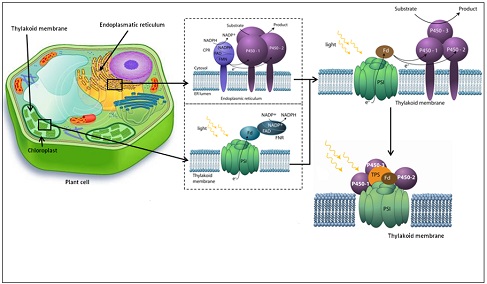Light-Driven Production Published in ACS Synbio

New article in ACS Synthetic Biology on Light Driven Production of High Value Compounds by Center for Synbio scientists Lærke Münter Lassen, Agnieszka Zygadlo Nielsen, Bibi Ziersen, Thiyagarajan Gnanasekaran, Birger Lindberg Møller and Poul Erik Jensen.
The article entitled "Redirecting photosynthetic electron flow into light-driven synthesis of alternative products including high-value bioactive natural compounds" is published online.
READ THE PUBLICATION ONLINE HERE
Abstract:
Photosynthesis in plants, green algae and cyanobacteria converts solar energy into chemical energy in the form of ATP and NADPH, both of which are used in primary metabolism. However, often more reducing power is generated by the photosystems than what is needed for primary metabolism. In this review we discuss the development in the research field focusing on how the photosystems can be used as synthetic biology building blocks to channel excess reducing power into light-driven production of alternative products. Plants synthesize a large number of high-value bioactive natural compounds. Some of the key enzymes catalyzing their biosynthesis are the cytochrome P450s situated in the endoplasmic reticulum. However, bioactive compounds are often synthesized in low quantities in the plants and are difficult to produce by chemical synthesis due to their often complex structures. Through a synthetic biology approach, enzymes with a requirement for reducing equivalents as cofactors, such as the cytochrome P450s, can be coupled directly to the photosynthetic energy output to obtain environmentally friendly production of complex chemical compounds. By relocating cytochrome P450s to the chloroplasts, reducing power can be diverted towards the reactions catalyzed by the cytochrome P450s. This provides a sustainable production method for high-value compounds that potentially can solve the problem of NADPH regeneration, which currently limits the biotechnological uses of cytochrome P450s. We describe the approaches that have been taken to couple enzymes to photosynthesis in vivo and to photosystem I in vitro and the challenges associated with this approach to develop new green production platforms.
For more information contact corresponding author Poul Erik Jensen
Read more about the some of the other researchers here
